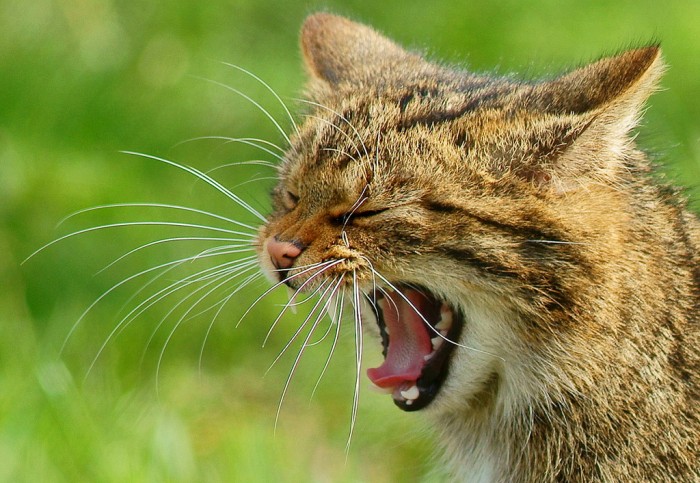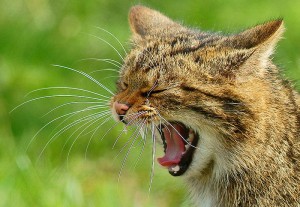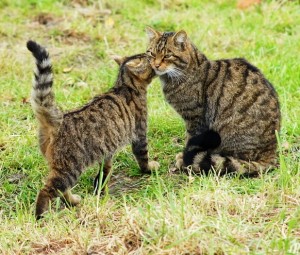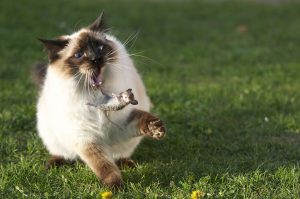War of Words Rages Between Wildcat Conservationists
The past week found efforts to conserve the critically endangered Scottish Wildcat hampered somewhat by infighting between conservationists boasting different ideologies on how best to deal with feral cats – the single biggest threat to Scotland’s remaining Wildcats.
 Image: By Peter Trimming - Yawning 'Kendra'Uploaded by Mariomassone, CC BY 2.0, https://commons.wikimedia.org/w/index.php?curid=18462225
Image: By Peter Trimming - Yawning 'Kendra'Uploaded by Mariomassone, CC BY 2.0, https://commons.wikimedia.org/w/index.php?curid=18462225 The woeful demise of the Scottish Wildcat (F. s. silvestris) is arguably one of the most pressing conservation concerns facing the UK at in current times. Indeed, now Britain’s most endangered mammal species, the wildcat now sits on the edge of an abyss – habitat loss, persecution and more importantly, interbreeding with introduced feral cats (Felis silvestris catus) pushing the iconic Highland denizen to the brink of extinction. It should come as consolation that recently the species has been subject to a high profile media campaign highlighting its plight and now is the focus of huge push to restore numbers. A push brought about by both Scottish Wildcat Action (SWA), the official body governing wildcat conservation, and Wildcat Haven – an independent group working towards the preservation of this much loved species.
With so many people working to reverse the decline of the wildcat it may seem that things are looking up for the feline though this week past conservation efforts found themselves hampered by infighting between the two groups. Infighting stemming from a fundamental disagreement on how best to deal with feral cats – the single biggest threat to Scotland’s remaining wildcats. The latest bout of distrust emerging after it was revealed that SWA have authorised the “humane dispatch” of feral cats trapped as part of the project – a move Wildcat Haven have branded as “barbaric and entirely unnecessary”.
It has long been known that Wildcat Haven stand virulently opposed to the killing of feral cats. The reasons for this centring on a number of factors but not least compassionate grounds and the risk that peoples pets could be mistakenly destroyed. WH state that lethal control measures pose a direct threat to wildcats that could be mistakenly killed in place of their feral counterparts and believe such measures may in fact not be beneficial to conservation measures on the whole – citing Australian research (found here) that concludes that killing feral cats simply encourages more to colonise the area in question. They believe that in order for lethal measures to succeed, the whole population of feral cats must be eradicated – admittedly, an unlikely prospect given the 1000/1 ratio of feral cats to wildcats in Scotland. Instead the group, funded by various overseas sources, champion a trap/neuter/return (TNR) approach.
This opposition this week lead Wildcat Haven to call for the “suspension and a detailed review of the Scottish Wildcat Action Plan” – a move that Wildcat Action, backed numerous professional bodies (a list of which I will include below) to accuse WH of “misrepresenting the progress made in wildcat conservation“. Eileen Stuart, head of policy and advice at Scottish Natural Heritage (SNH) later called on wildcat haven to produce evidence of their activities in order to ensure the two parties can work together in the future.
Disputing the claims of wildcat haven whom claim feral cats are trapped simply to be “blasted in the face with a shotgun” WA state that, contrary to the claims put forth by the group, all trapped feral cats are humanely euthanised by their veterinary team – after being rigorously tested to determine their credentials. They state that such moves are in fact a lot safer than previous means of cat control such as nocturnal shooting which could lead to the inadvertent death of pure wildcats. Wildcat action have also made moves to return feral cats to their original location, though often landowners refuse to accept hybrid or domestic cats back on their land, leaving no option but to destroy them.
Surely I cannot be the only conservationist out there feeling a little, frustrated shall we say, at the current war of words raging between the two sides. Though undoubtedly full of good intent, wildcat haven by calling for a cessation to the current wildcat action plan appear to be directly opposing conservation measures aimed to protect the species they claim to adore and why? Because of the deaths of a feral cats – a non-native species that has no place in the British ecosystem. There may well be truth in the notion that killing feral cats simply encourages more into the target area – the same thing happens with foxes, a wealth of available resources proving too good to turn down. What choice is there however when landowners refuse to take feral cats back onto their property. Why would they? These are, after all, an invasive species that is going to hunt and kill various native critters thus putting further strain on an already embattled ecosystem. Personally I am not opposed to destroying cats once all necessary steps to return them have been rebuffed. This is not born of a dislike for the feisty felines (I own cats) but out of realism and an understanding that Wildcat Action are doing what must be done.
I sincerely hope that the two sides can set their differences aside soon and work together towards a common cause – the preservation of one of our islands most iconic predators. Should this prove impossible then maybe Wildcat Action should evaluate their ties to the opposing group. Oh and in case you were doubting the credentials of Wildcat Action the full list of those supporting the scheme can be found below:
“Scottish Natural Heritage, the Royal Zoological Society of Scotland, National Museums Scotland, Edinburgh University’s Royal (Dick) School of Veterinary Studies, the Cairngorms National Park Authority, the National Trust for Scotland, Forestry Commission Scotland, the Scottish Gamekeepers’ Association, and the Scottish Wildlife Trust“




4 Comments
Here is glaring proof of how, as cat-hoarders so often and mindlessly respew, “Trap-Neuter-Release is the most effective means of managing feral cat populations. In fact, it is the only proven way to do so.”
The residents of the UK who invented that TNR lunacy in the 1950’s have been relentlessly practicing that failed ideology NATIONWIDE for over 60 years now. And all they have managed to do with TNR is DOUBLE their vermin cat populations — from 4.1 million vermin cats in 1965 to 7.9 million vermin cats in 2014. And to help, all this time they are still killing them in shelters and legally shooting them to death in rural areas under their animal depredation-control laws. By foolishly hoping and praying that their very own TNR concept will reduce vermin cat populations someday they have now even driven their one and only NATIVE cat species to extinction with their invasive-species vermin “moggies” (feral house-cats) — with less than 35 “Scottish Wildcats” left in the whole world. (Along with 421 other species that they have already made extinct in the last 200 years — over 2 species per year gone forever due to British cultural beliefs, practices, and values.) All the while they still insist that practicing their failed TNR policies will still save their “Scottish Wildcat” from being wiped from the earth forever. You can kiss their “Scottish Wildcat” good-bye too now. (Laughably ironic if it weren’t so pathetically, globally, and PERMANENTLY sad.)
Nice plan. TNR sure does work, doesn’t it!
You know that saying about doing the same thing over and over again and expecting a different result. The British have proved the failure of their vermin cat-insanity for over 60 years now. You too can be just as ecologically destructive, ignorant, and just as insane as the inbred mentalities of the Toxoplasma gondii brain-damaged moggie-licking British by practicing and promoting their failed-belief in their TNR concept! 🙂
You know what DOES work? Hunted to extinction. It worked where I live! And all accomplished in only 2 seasons of my time, where before there were hundreds and hundreds of them destroying all the native wildlife for decades. I’ve not seen even ONE non-native vermin “moggie” anywhere in the whole area, for miles around, going on over 6 years now. I turned my lands into a 100%-fatal cat-trap for all vermin house-cats — collared or not, they all die now — no delays, no excuses, no exception. ZERO TOLERANCE. See cat, shoot cat. It’s that simple and that effective. And if you’re lucky enough to get your ammo on a close-out sale like I did, 5,000 rounds of .22s for only $15, you can accomplish all this for less than the price of a couple cups of coffee.
My understanding of the distrust between the two sides is that Wildcat Haven have created a vast safe habitat for wildcats to live and breed in, and SNH are demanding to know when and where wildcats have been seen by WH so they can catch them and take them off for their captive breeding programme. I do understand there are two side to every story, and picking your way between these stories to arrive at a truth is difficult, but I have so far found Wildcat haven’s responses to SNH more fulsome and clear than all the establishment organisations responses, which seem to always fudge the issues. My thoughts are that the best option is for both wild and captive breeding should be supported to give the best chance of wildcat survival in Scotland. I really hope that the outcome for our wildcats is a good one.
A list of the schemes supporters does not make what they are doing right, especially when you have Gamekeepers involved (they being one of the causes of the Wildcats demise). Just look at the UK government killing Badgers, fully supported by NFU but not by scientists. What you omit from your article is that the SWA wants any Wildcats found in the Haven to be incarcerated into a breeding programme whare any offspring will be fed dead animals, this is not natural behaviour for cats and only has a 20% history of sucess. The haven has 800 square miles of Wildcat habitat free of fertile ferals, why can’t they be left to continue their good work without interference from the SWA?
Wildcat Haven have been quietly getting on with the job of clearing feral and obvious hybrids from a huge peninsula for the last five years. They have used proven TNR with regard for the feelings of local cat owners and the needs of the wildcat. Releasing neutered dats back into their territories prevents intact cats moving in, whilst ensuring that any wildcats only breed with other wildcats.
Then along comes big government, partnered with zoos, wildlife parks and gamekeepers. Their plan is to strip all wildcats from the countryside and shoot anything else. Great for the zoos and wildlife parks, they get captive wildcats and a captive breeding programme to provide cute kittens. The gamekeepers get cat free grouse moors. The Scottish Wildcat gets stuffed.
This is a time to nail your colours to the mast. If you want the Scottish Wildcat to survive in the wild, back Wildcat Haven. If you just love zoos and think that Scotland should be a rich man’s shooting range, back SNH.